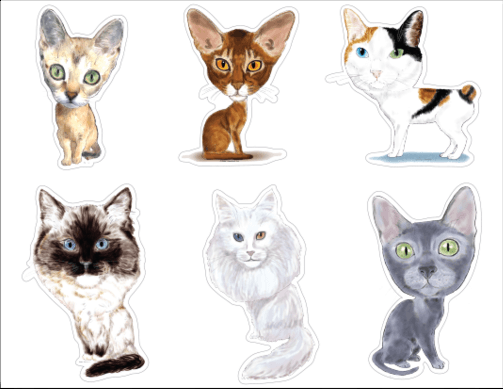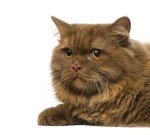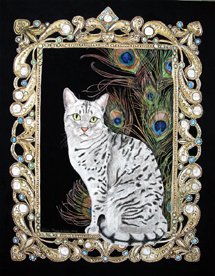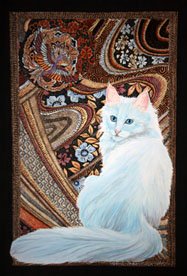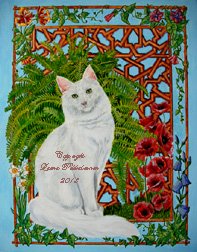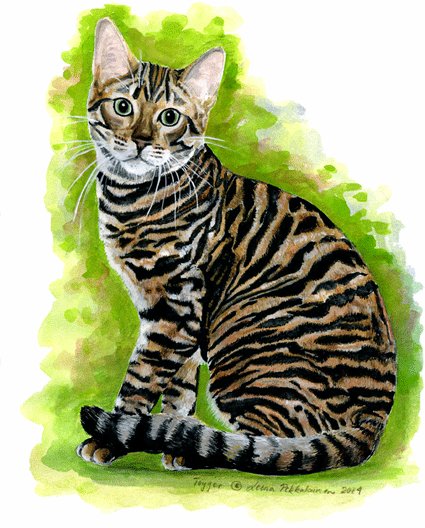Cat Diarrhea
A Symptom of Many Illnesses
Cat diarrhea is not an illness as such, but rather a symptom of other diseases and imbalances in the cat’s body – especially if it is chronic. You should always remember that if you suspect your cat's stomach is not functioning properly, you should consult your veterinatian quickly. These conditions are far more dangerous to cats than they are to humans.
|
here are three categories to this unpleasant symptom: Acute cat diarrhea begins suddenly and lasts less than 2-3 weeks, often only under 48 hours. Chronic cat diarrhea lasts more than 2-3 weeks Intermittent cat diarrhea; the symptoms coma and go and come again in a period of several weeks. |
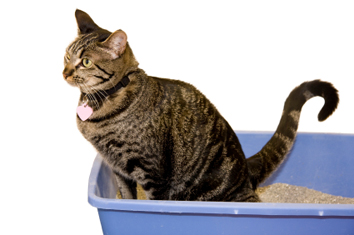 |
There are many causes of feline diarrhea. But generally speaking cat diarrhea is a defense mechanism – the body gets quickly rid of any unsuitable matter which inflames or irritates the lining of the intestines. Any ingested material moves rapidly through the intestine. The cat needs to hurry to the litter box more often, its feces are loose and there can be quite a lot more of feces than normally.
If the unsuitable thing the cat ingested is high in its digestive tract, the cat vomits it out. If, however, it is lower in the digestive system (stomach), then the intestines speed up the process, push out the matter faster and stops water re-absorption from the gut, which makes the feces more watery. Because of this there is a very strong danger of dehydration.
Most often the cause is only temporary, and even though diarrhea can be quite painful to your cat, it passes in a day or two.
Here are listed some illnesses that have cat diarrhea as their symptom.
Age
When a cat gets older, its digestive enzyme capability may be reduced. Kittens, on the other hand, are more likely to get internal parasites. In both these cases cat diarrhea may result.
Anaphylactic Shock
This is a sudden, violent allergic reaction, and may cause bloody cat diarrhea or dark stools.
Bacterial Infections
These may be caused by many kinds bacteria, for example campylobacter, clostridia, E. coli, salmonella, staphylococcus. Bacteria may develop on poorly cooked meats and chicken – one reason some vets recommend a diet of cooked meat to your cat, instead of a raw diet.
If this bacterial infection is caused by spoiled food, the cat diarrhea it causes is usually over rather quickly.
Salmonella can also be passed by adult cats to their kittens.
The symptoms can be bloody cat diarrhea, loss of appetite, depression, fever and vomiting. Usually cats heal well from such a bout of bacterial infection, but if the lining of the intestine is damaged and bacteria can enter the cat’s blood stream, the situation may be quite dangerous.
Blockages in Intestines
This kind of blockage can be caused by hairballs (especially in long haired cats) or other foreign objects (more likely to happen with kittens as adult cats are muck pickier about what they swallow). Also a tumor may cause a blockage, or the gut may be twisted – these conditions may need traditional surgery to remove the blockage. And of course the blockage may simply be poop.
Bowel Malabsorption
The bowel wall does not function properly and so doesn’t absorb nutrients well – the food breakdown remains incomplete. This causes problems with the liver and pancreas, and causes cat diarrhea.
Cancer
Cat diarrhea may also be caused by cancer, especially when it is a question of an older cat. Other symptoms are weight loss, poor appetite, vomiting and dark, tarry stools. Unfortunately, if it is a question of cancer, the prospects of healing are poor.
Chemicals
There are plenty of chemicals in our environment that may cause cat diarrhea. For example normal cleaning agents in the home. So especially if you have a kitten, be sure to hide your chemicals to a place it cannot reach. (Some cats learn to open doors pretty quickly, and if this is the case with your cat, put the dangerous chemicals in a locked place)
Colitis
Colitis is the inflammation of the lining of the large intestine (or colon) - causing cat diarrhea.
Colon Impact / Feline Impacted Bowel
This situation is cause if a cat is chronically constipated. It may visit the litter box frequently, but doesn’t manage to poop other than a small quantity of diarrhea.
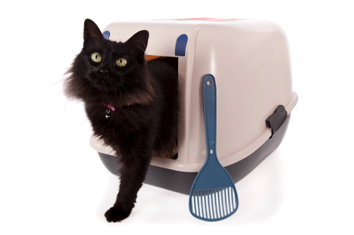
Exocrine pancreatic insufficiency
The exocrine function of the pancreas means that the pancreas secretes enzymes via a duct. Exocrine pancreatic insufficiency means that the pancreas fails to produce enough pancreatic enzymes, and this makes the cat unable to digest its food properly.
This disease is rather rare in cats, and occurs especially in cats with a history of pancreatic problems.. Its symptoms are cat diarrhea (lots of it, pale yellowish in color, greasy and foul smelling), flatulence and increased appetite. yet weight loss The cat’s fur may begin to look greasy.
Siamese cats may be predisposed to this illness. Healing prospect depends on the severity of the illness.
Feline inflammatory bowel disease (Feline IBD)
This disease causes an inflammation of the lining of the digestive tract, especially in middle-aged cats. It is not infectious. The cat’s own immune systems attacks the mucosa or lining of the intestine. Its symptoms are chronic vomiting and cat diarrhea with possible mucus. Sometimes there is straining when the cat goes to the litter box. It may also have constipation and black and tarry stools.
Feline Lymphoma
Symptoms are chronic vomiting and diarrhea.
Feline Salmonellosis
Symptoms vary from abdominal pain, diarrhea, fever, poor appetite to vomiting.
Food and Drink – And Non-food Items
Food allergies can develop with age, so things your cat could eat when younger may cause trouble in later years, even developing into full blown allergy. Things that may cause food allergies are coloring agents and far processed cat foods. They contain non-foods that cause your cat’s gut to work overtime - something you would not want to happen if the cat has diarrhea. Try food brands that have no dyes or additives.
Diet changes also usually cause a cat diarrhea – be prepared for it if you change your cat’s food brand. Change in cat food brand or high fat meat can be the reason for an upset tummy. Usually there are no other symptoms except the diarrhea (often with gas). One big cause of diarrhea in cats is milk. Kittens still have the body enzyme necessary to digest milk for the obvious reason – they are still nursing. But an adult cat’s body cannot handle lactose, especially if they have not been drinking it continually since kittenhood, so even though your cat likes the taste of milk, do not give ordinary milk to it. There is special cat milk on sale which is much better for your cat. Also check does your commercial cat food have milk in it.
And often the more expensive cat food just is of better quality (this does not mean you need to buy the most expensive brand on the market, there are plenty of excellent middle-priced ones). Generic, cheap brands may cause tummy trouble in your cat. Don’t let yourself be mislead by such terms like “high protein content”. That can mean anything from hooves to beaks and feathers. Protein in this form can be quite indigestible and cause diarrhea.
So if you find a good cat food brand, stick to it. And remember that if you cat’s stomach is very delicate, the food batches of very small cat food companies may vary. In this case a cat food made by a big company may be of more even quality
Also if you feed your cat only once a day, it may gobble huge amounts of food, knowing it takes a while to get more. This may cause colic, diarrhea and vomiting. If the cat’s feces are large and poorly formed, you should reduce the amount you feed your cat. It is preferable to give your cat three small meals per day instead of one big meal. If you can trust your cat not to eat everything immediately, you could leave food so that it can eat it when ever it wants to. Some cats, however, just don’t have the self control… (You can read about it HERE. ) Overeating overloads the spleen and this causes diarrhea. Not to mention what other health problems overeating causes.
Cat may also have eaten something sharp (do not leave your sewing kit out in the open!)
And if you are certain you have fed your cat proper food, have you considered that if you let your cat out, the neighbors may give it improper food (and cats love those helpful neighbors, of course…) Also, while roaming free outside, the cat may drink contaminated water.
One important thing to remember is that if the cat has eaten some foreign item it may try to vomit it back up. In such a situation it may be possible you see a part of the object in the cat's mouth. The logical thing to do would seem to be to help the cat by pulling the object out. DON'T! It may have entangled with the cat's intestines and pulling it may cut the intestines. Instead take the cat to the veterinarian immediately.
Hyperthyroidism
This is mostly an illness in middle-aged or older cats. The symptoms are hyperactivity, increased amount of feces (which can be greasy), cat diarrhea and increased appetite. The healing prospect is good with proper treatment.
Irritable Bowel Syndrome
This happens especially in stressed cats. The symptoms are diarrhea with mucus, blood and increased straining. The prospect of healing is not always good, and the cat should be put in a highly digestible diet.
Medication
Many kinds of medication may cause diarrhea in cats. Especially antibiotics and sulfas, which kill the good bacteria in intestines, can cause diarrhea. This is called the sterile gut diarrhea and it is caused by both injected and oral antibiotics.
Obstruction in intestines
This means the cat has a foreign body in its bowels. A cat may swallow plastic and rubber strings, and the Christmas tree tinsel is quite irresistible to a cat. Anything that resembles grass, really. I know of one family who lost their cat because the rubber band she had swallowed caused the intestines to fold over and block. And the first Christmas I decided to decorate the tree with those long tinsels taught me it was not a good idea. Lets just say that the litter box sparkled for quite a while, even though I hastily took off all the tinsel I could see in the Christmas tree…
A bowel obstruction, as odd as it sounds, may cause diarrhea – but only a little of it.
The symptoms are abdominal pain, depression, diarrhea, loss of appetite and vomiting. If the obstruction is severe, surgery may be necessary. The prospect of healing is good, if the condition is treated immediately, and the intestine has not been perforated. So do not hesitate to take your car to the vet, if you suspect it has a bowel obstruction.
Parasites
There are many kinds of parasites. There are intestinal worms and single-celled organisms. Cats may pick up infective worms simply by walking outdoors. These are infections that may pass into people too, so be sure no one in your household is exposed to cat stool.
WORMS
Roundworms are a problem especially with kittens. They cause diarrhea, loss of weight and poor growth. The cat heals well with the proper wormer (but may require multiple treatments).
Hookworms again affect especially kittens. The symptoms are diarrhea, vomiting and weakness. The cat may have pale gums and anemia, and a swollen abdomen. The feces are black and tarry. This condition heals very well with the proper wormer.
(When we got a kitten from the countryside years back, he was 10 weeks old. We first drove him to the vet, because we had another cat already, and the kitten had received no vaccinations. The kitten had a bulging belly, and the vet immediately realized it had hookworms. The kitten was vaccinated and wormed and I never forget that sight when he went to the litter box. The worm that came out must have been longer than the tiny kitten itself… It was a disgusting sight, still moving in the box…)
PROTOZOAN / SINGLE-CELLED PARASITES
Coccidia occurs especially in kittens and especially in crowded environments. The symptom is diarrhea which may contain mucus, even blood. This condition heals usually well with sulfa antibiotics.
Cryptosporidium is protozoan (single-celled) parasite. It causes diarrhea which may have blood and mucus. Weight loss is another symptom. If the cat has a healthy immune system, its body gets rid of the parasite on its own. There is no effective medication for this condition.
Giardia affects especially kittens. Its symptoms are diarrhea with mucus and bad odor, abdominal pain, vomiting, weight loss. It is an intermittent diarrhea – comes and goes. It heals very well, but easily comes back again and required careful cleaning of the cat’s environment and coat.
Tritrichomonas is also a single-celled parasite which occurs especially to cats in crowded environments. These can be catteries or shelters. The symptoms are soft feces with mucus, there may be some straining also. This is a difficult thing to weed out from a cattery, but an individual cat should heal well.
Poisoning
This, luckily is a rare occurrence, as cats are picky about what they eat. Kittens, however, may eat all sorts of things. And sometimes cats like the strangest things, like anti-freeze. For some reason it tastes good to them, but is poisonous. Also fertilizers, heavy metals and insecticides are poisonous, as are some house plants and slug baits.
And one symptom of poisoning is, of course, diarrhea.
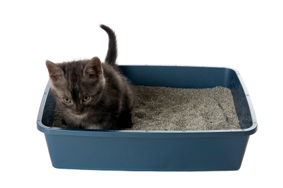
Short Bowel Syndrome
This is a condition of cats who have a part of their small intestine surgically removed. It may cause diarrhea that does not respond to treatment, and the healing prospect is not always good.
Stress
Stress is known to cause diarrhea in cats. And basically any kind of change in a cat’s environment may cause stress.
It is important for you to remember not to scold your cat for the accidents. The cat cannot help it – you should know if you ever had diarrhea. Scolding only increases the cat’s stress. It is naturally a very clean animal and is quite likely very embarrassed about the mess it makes.
Systemic Diseases
These are problems in kidney and liver, and also diabetes mellitus. Usually these ailments are found in older cats. The symptoms are depression, dehydration, increased thirst and changes is drinkin habit (especially with diabetes) and as a result changes in urinating frequency.
A stressed-out cat may be stress-eating. Many humans have the same response to stress – munching away seems to give some kind of feeling of security. But this over-eating may cause tummy trouble. If it causes a blockage, a gentle laxative may help (with the advice of your vet). Keep your eye on the cat for a few days after this, and if there are any strange symptoms, get your cat to the vet.
Tumors
Tumors in the digestive tract may also cause diarrhea.
Upper Gastrointestinal Bleeding
This may also cause diarrhea.
Cat Diarrhea:
VIRAL INFECTIONS (FeLV, FIV, Panleukopenia, Rotavirus)
Viral infections are the most common cause of cat diarrhea.
Feline Corona Virus (FCoV)
This is a highly contagious virus that affects especially kittens and cats in crowded conditions (such as catteries and animal shelters). It is rarely fatal, but may cause unpleasant diarrhea for 2-5 days, fever, loss of appetite and vomiting. Usually the condition heals on its own but there is a change it may develop into feline infectious peritonitis which is a very severe illness.
Feline Distemper / Panleukopenia / Feline Infectious Enteritis
This highly contagious viral disease causes abdominal pain, dehydration, depression, diarrhea (which can be severe, bloody and runny), fever, low white blood cell count, seizures and vomiting. It is caused by a parvovirus, and can be highly lethal, especially with unvaccinated kittens. Even when treated, may cause the cat to become prone to diarrhea.
Especially young cats may have trouble healing.
Feline Immunodeficiency Virus
This slowly working virus causes immunodeficiency, which means the cat cannot protect itself against infections. One sign of this unfortunate illness is chronic diarrhea (about 20% of the affected cats get diarrhea). Other symptoms are loss of appetite and weight loss.
It is spread usually by saliva (bite wounds from an infected cat).
The healing prospect is poor.
Feline Infectious Peritonitis FIP
This viral disease affects especially kittens, and cats in crowded conditions. It has a poor healing prospect, can be deadly. Some breeds may be more genetically prone to get this (like the Burmese and Persian cats).
Feline Leukemia
This viral disease is most commonly transferred when cats fight – a bite from an infected cat is enough to transfer the virus. So the outdoor cats have a higher possibility of catching this disease. It affects especially the younger cats severely.
The symptoms are bloody, chronic cat diarrhea (or constipation), breathing problems, listlessness, poor appetite, extreme thirst weight loss. The healing prospect is poor.
You can read more about cat diarrhea treatment by clicking here!
Back to Homepage from Cat Diarrhea
Go to Feline Diarrhea Article
Go to Feline Diarrhea Treatment
Back to Cat Illnesses
The picture of a tabby cat using the litterbox: copyright by lesliejmorris at IstockPhoto. Do not copy.
Picture or a black cat coming out of litterbox: copyright lusoimages at IstockPhoto. Do not copy.
Picture of a kitten using the litterbox: copyright princessdlaf at IstockPhoto. Do not copy.
Disclaimer: This website is not intended to replace professional consultation, diagnosis, or treatment by a licensed veterinarian. If you require any veterinary related advice, contact your veterinarian promptly. Information at cat-breeds-info.com is exclusively of a general reference nature. Do not disregard veterinary advice or delay treatment as a result of accessing information at this site.

Leena's Books
Tutankhamun
|
This book travels with the King Tut - Treasures of the Golden Pharaoh exhibition on his world tour of ten cities from March 2018 onwards |
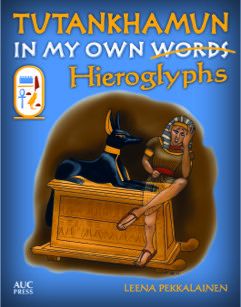 |
|
Tutankhamun: In My Own Hieroglyphs tells the story, for older children, of the life and afterlife of the famous young pharaoh in his own words. Tutankhamun tells us about the trouble he got into as a child in Akhenaten's palace in the new city of Akhetaten, and how he became a boy pharaoh. As we learn, his life changed a lot when he died as a teenager, and long years of boredom started in his tomb with only his pet monkey Fingers and his treasure for company. He did meet some of the Egyptian gods, of course, and had fun scaring off tomb robbers, but it was mostly rather dull. Then one day, some new and strange people, including a Mr. Howard Carter, arrived and began to take all the treasures out of his royal tomb. Fortunately, through the eyes of his beautiful golden mask, Tutankhamun, could have fun again traveling around the world |
Mr Mummific
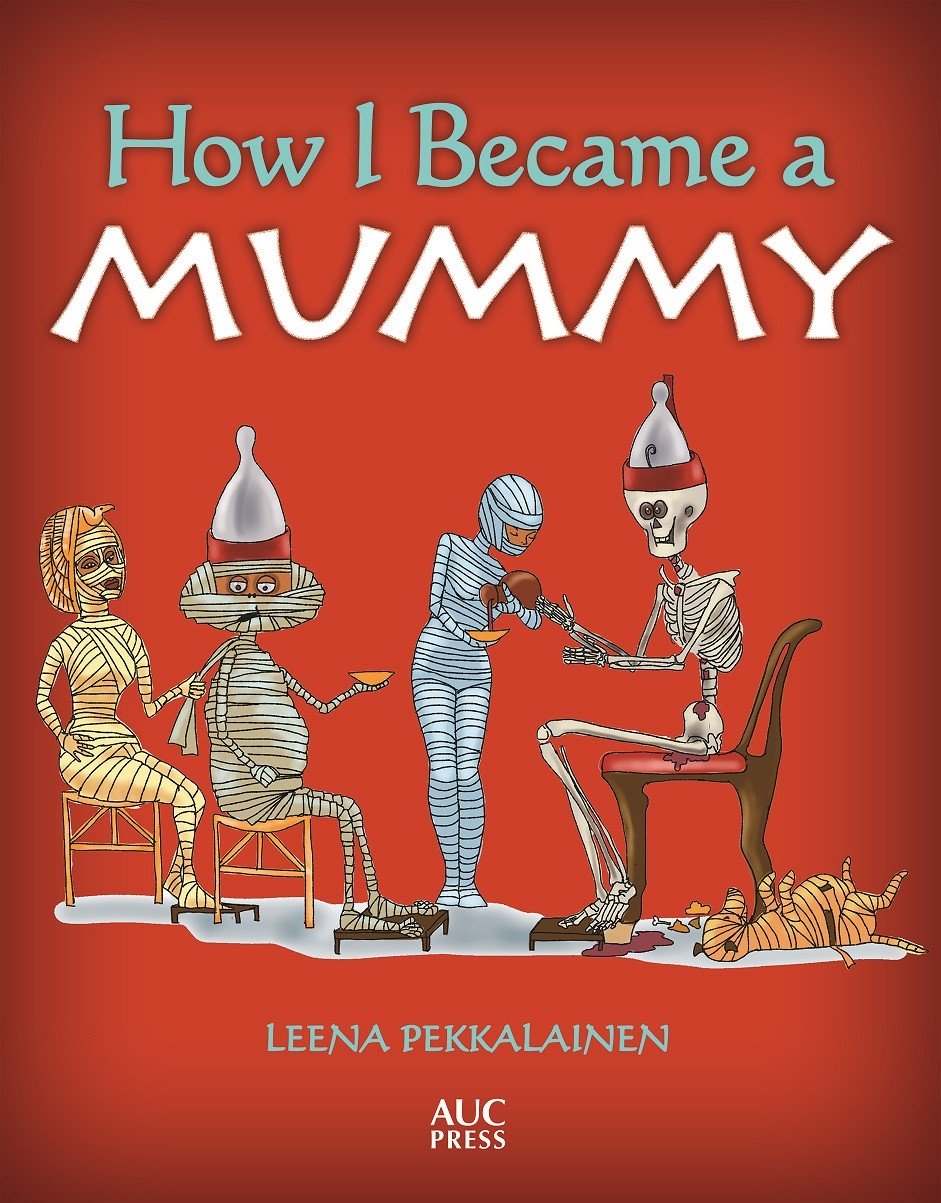
|
An ancient friend of mine, Mr Mummific dictated a book about how he became a mummy - and I was his scribe and artist. The book is available at Amazon.com and Amazon.co.uk On my other website www.ancientagypt101.com he continues his stories about life in ancient Egypt. |
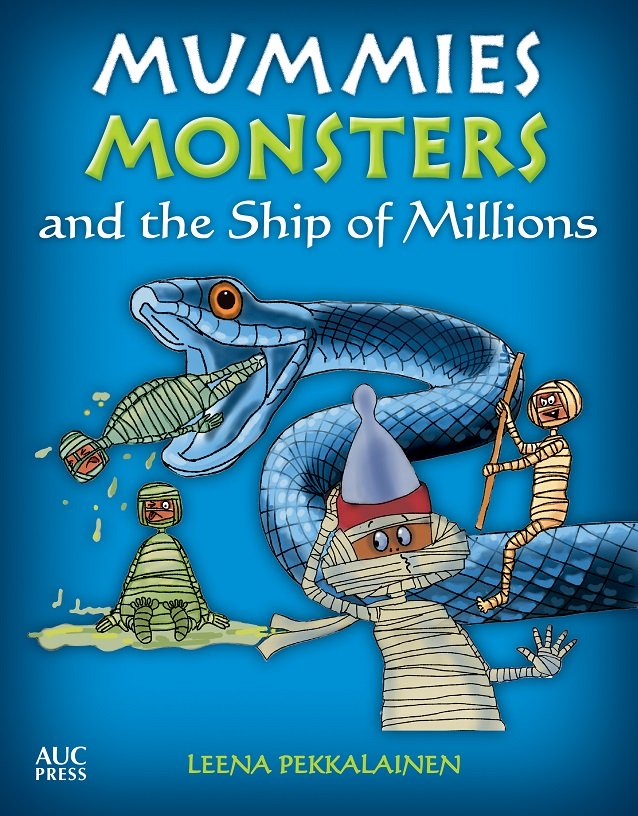
|
Another hilarious adventure for children with Mr Mummific, the mummy with attitude. He now tells the story of his mishaps, misunderstandings and misadventures as he leaves his tomb through the False Door to embark on the complicated and dangerous journey to the Afterlife aboard the magnificent Ship of Millions. Find the book at Amazon.com and Amazon.co.uk |
The Nephilim Quest Series
The first book in an epic fantasy series based on human mythology. The search for the mythical Watchers, the angels who fathered the Nephilim, the half-angels. A story that moves on three levels - our times, ancient Greece and ancient Egypt.
Preview Nephlim Quest 1: Shadowhunter online
***
My Author Website at leenasbooks.com
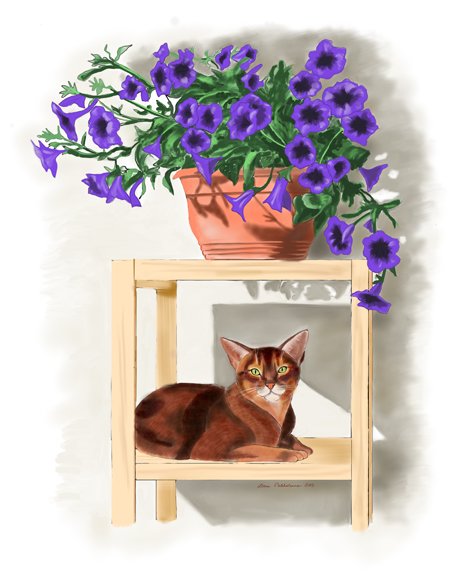
If you are looking for demanding coloring, check:
Online Coloring Books Magazine - No.1
It shows you step by step how to color this pretty Abyssinian cat with flowers. Each page has a color sample, and all the techniques are explained.
